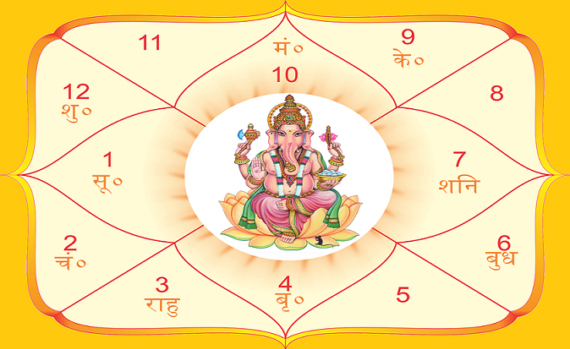- Vedic Astrology Basics Lesson 1
- Vedic Astrology is the observation of the interplay between the planets and our Earth. (Astrologers call the Sun and the Moon planets for the sake of convenience, although they are actually luminaries. From this point forward, “planets” refers to the planets and the sun & moon). Through thousands of years of observation, two things have been noted:
- Each planet represents an energetic part of our being, or a component of life (i.e. emotions, communication style, love style).
- The position of each planet in the heavens indicates the style in which the planet’s component is manifested.
- Natal astrology observes that the positions of the planets at the moment of your birth indicate the style in which each planet’s component is manifested in your life.
- As far back as ancient Babylon, astrologers divided the heavens into the 12 sections of different styles (or archetypes) that had been noted. Those are the 12 signs of the zodiac.
- astrology historical observation
- Basic astrology takes four things into account:
- The planets (including the Sun and the Moon)
- The zodiac signs which the planets are in
- The Houses
- Aspects
- From our view on Earth, the planets, sun, and moon appear to orbit around us along an apparent path near the ecliptic. (A geocentric view is effective in astrology because we study the interaction between the rest of the universe and us here on Earth.) As they orbit, they travel through the 12 zodiac signs. Most of you know the sign in which the sun is at any given time – Aries from the end of March through most of April, then Taurus, then Gemini, etc. The sun takes one month to travel through each sign, and circles the entire zodiac in one year. As a matter of fact, that is where our concept of “year” comes from. The moon travels the entire zodiac in one month. In fact, our word “month” comes from “moon.” Our entire concept of time came about because of the solar and lunar cycles around the zodiac. The first ancient astrologers were very observant.
- zodiac wheel around earth, ancient astrology art
- Because this apparent path along the ecliptic is basically flat (maximum deviation of about 8 degrees), we can draw a flat, 2-dimensional drawing to represent it. Naturally, we draw a circle. This circle is sliced into the 12 zodiac signs. The planets, as designated by their actual positions in space, each fall into one of the 12 zodiac signs. Each planet also falls into one of the 12 Houses. The Houses will be discussed later. Aspects are certain angles, or degrees of separation between planets, or between a planet and a point. Astrologers divide the heavens into a 360-degree circle, and the planets are arranged upon it. When planets are 0, 60, 90, 120, or 180 degrees apart, they are said to be in major aspect. Other degrees of separation are considered minor aspects. (See detailed information on aspects.) Planets in aspect have a dynamic relationship, which astrologers study carefully. Aspects between planets are, by and large, the determining factor that decide whether a planet’s energy is manifested easily or with struggle (positively or negatively) in your life. This is because, traditionally, some aspects are considered negative while others are considered positive. Modern astrologers have evolved and proclaimed that all aspects can be used constructively. In astrology, aspects are where the action is. Without aspects, the celestial stage and planetary actors are silent and still. Aspects awaken the planets into the full expression of their energies.
- For organization, astrologers make charts to include everything mentioned above. The astrology chart is a map of the heavens for a specific moment in time. The astrology chart is called a horoscope. In ancient days, they were not customarily drawn up for people’s birth times. They were cast for the time of certain events, such as wars, crownings, or festivals. Only pharaohs and kings would have one cast for their birth time. Nowadays anyone can get his or her birth chart drawn. A birth chart is interchangeably called a natal chart or horoscope. Your birth chart is your real horoscope, but we don’t use that word much anymore because it has been devalued to mean “a false daily prediction based only on your sun-sign.” Your natal chart can only be cast with an accurate birth date, birth time, and birthplace. We believe that your birth chart is the most valuable tool you can have in your possession.
- For convenience, astrologers use glyphs (symbols) instead of words on charts. This makes it easier to see all of the information arranged on the chart. Please take a moment to learn the glyphs used in astrology (see Lesson 2). After that, you can continue to Lesson 3: “Birth Chart Layout.”
- zodiac band around earth in outer space
Introduction to Vedic Astrology
- Most people in the western world are not family with Vedic astrology. This articles provides an introduction to Vedic astrology and its history.
- Vedic astrology is more than 10000 years old, but no ones knows exactly how old the Vedic period is. The Vedic time period is still debated, but is considered to have originated in the Indian subcontinent. Unlike modern science and technology, this Vedic period was the time frame where people used Vedic knowledge in their daily life. There was a set health care system named Ayurveda. This system is now a very big industry. Astrology or Jyotish is a branch in that Vedic lifestyle. Jyotish means nothing but knowledge of light.
- Veda means a lot in Sanskrit. It means sacred knowledge, sacred lore, finding, perception, true knowledge and much more. The knowledge about Vedas have spread in four texts Rig veda, Yajur veda, Sama veda and Atharva veda. There are so many scriptures from these books mentions astrology.
- Even though there are many texts available about Vedic astrology, Vedanga Jyotish can be considered as main text which is supposed to be originated in the later part of the Vedic era. It is all about astronomical calculations and astrology as well.
- The western astrology system is ahead of Vedic astrology by 23 degrees. For example, if the Sun in a Vedic birth chart is at 20 degrees Sagittarius. A western birth chart will show the Sun to be within the early degrees of Capricorn. So, the calendar is quite different between the two systems. Accordingly, the dates of the months also change. The two systems are name western and eastern calender’s.

Eastern Calendar (Vedic)
Aries Vedic Zodiac Sign
April 14 – May 15
Taurus Vedic Zodiac Sign
May 15 – June 15
Gemini Vedic Zodiac Sign
June 15 – July 16
Cancer Vedic Zodiac Sign
July 16 – August 17
Leo Vedic Zodiac Sign
August 17 – September 17
Virgo Vedic Zodiac Sign
September 17 – October 17
Libra Vedic Zodiac Sign
October 17 – November 16
Scorpio Vedic Zodiac Sign
November 16 – December 16
Sagittarius Vedic Zodiac Sign
December 16 – January 14
Capricorn Vedic Zodiac Sign
January 14 – February 13
Aquarius Vedic Zodiac Sign
February 13 – March 14
Pisces Vedic Zodiac Sign
March 14 – April 14
Vedic Planetary System
In the Vedic system of astrology, prominence is given to nine planets. Which are known as Nava Grahas. They are here with their Sanskrit names
Sun
Soorya
Moon
Chandra
Mercury
Budha
Venus
Shukra
Mars
Mangala
Jupiter
Brihaspati
Saturn
Shani
North Node
Rahu
South Node
Ketu
Even though these planets can insight into our destiny. The true results are derived from the placement of Nakshatras or Lunar Mansions which lies behind the planets. At this point, Western astrology students may get confused. There are 12 signs; planets are traveling through these signs. There are other constellations which behind these planets other than these 12 signs. These constellations are 28 in number. They are known as lunar mansions or nakshatras. Among these 28 nakshatras 27 are known as feminine nakshatra and the 28th one is considered as the male entity. So, for astrology consultation, only 27 nakshatras are taken into consideration.
These 27 lunar mansions or nakshatras makes Vedic astrology more detailed. However, Western astrology is more easy to understand. In the next chapters, we will study more about Vedic astrology. Vedic astrology chart has 12 houses like the western chart. The matters allotted to each house are almost all the same, but there is much more in Vedic astrology.
This introduction to Vedic Astrology was written by Shri Varun Singh Ji Vedicguruji












all comments